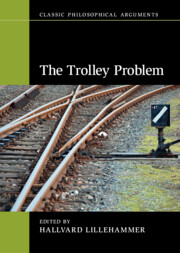Book contents
- The Trolley Problem
- Classic Philosophical Arguments
- The Trolley Problem
- Copyright page
- Contents
- Tables
- Contributors
- Acknowledgments
- Introduction
- 1 Keeping track of your trolleys
- 2 Shunted trolleys and other diversions
- 3 Must we turn the trolley?
- 4 Non-consequentialism in light of the trolley problem
- 5 Non-consequentialist principles under conditions of uncertainty
- 6 The trolley problem and the doing/allowing distinction
- 7 Virtue ethics and the trolley problem
- 8 Trolley dilemmas from the philosopher’s armchair to the psychologist’s lab
- 9 Trolleyology
- 10 Cross-cultural responses to trolley problems and their implications for moral philosophy or
- 11 Ethical accident algorithms for autonomous vehicles and the trolley problem
- 12 A new trolley problem?
- Bibliography
- Index
5 - Non-consequentialist principles under conditions of uncertainty
A framework
Published online by Cambridge University Press: 24 February 2023
- The Trolley Problem
- Classic Philosophical Arguments
- The Trolley Problem
- Copyright page
- Contents
- Tables
- Contributors
- Acknowledgments
- Introduction
- 1 Keeping track of your trolleys
- 2 Shunted trolleys and other diversions
- 3 Must we turn the trolley?
- 4 Non-consequentialism in light of the trolley problem
- 5 Non-consequentialist principles under conditions of uncertainty
- 6 The trolley problem and the doing/allowing distinction
- 7 Virtue ethics and the trolley problem
- 8 Trolley dilemmas from the philosopher’s armchair to the psychologist’s lab
- 9 Trolleyology
- 10 Cross-cultural responses to trolley problems and their implications for moral philosophy or
- 11 Ethical accident algorithms for autonomous vehicles and the trolley problem
- 12 A new trolley problem?
- Bibliography
- Index
Summary
We explore whether there is a plausible probabilistic version of the Doctrine of Double Effect (DDE), and more generally pursue the question of how probabilistic outcomes affect the application of moral principles. Many think that the DDE helps explain why it is permissible to shunt a trolley onto a sidetrack to which one person is tied (thereby resulting in his death) in order to save the lives of five people tied to the main track, whereas it is impermissible to lead an unsuspecting person onto the main track in order to save the five. But we can ask: Does it make a difference if we have an option to lead a person onto the main track when there is only a small to moderate chance that he will be killed? Here we make a start toward an answer by investigating why it is generally wrong to risk harm to others, taking as a defeasible starting point a pluralistic deontological account of morality. In the process, we explore whether imposing risk is causing harm, how to sort permissible from impermissible risk impositions, and why we should not expect a linear function between degree of risk imposed and seriousness of wrong.
Keywords
- Type
- Chapter
- Information
- The Trolley Problem , pp. 79 - 100Publisher: Cambridge University PressPrint publication year: 2023
- 1
- Cited by



